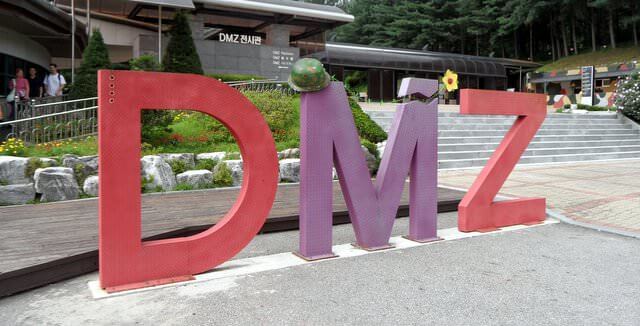
The Demilitarised Zone(DMZ) is a 241km long strip that has separated North from South Korea since the end of active hostilities in the Korean War. The ceasefire was signed and the DMZ formed in 1953, but the war has never officially ended leaving this as the last Cold War border in existence.
We had originally booked this tour for the day before but at the last minute got an email that the UN needed the meeting area for peace talks more than tourism so our trip to Panmunjom was cancelled and we went on a reduced tour a day later.
Everyone in North Korea volunteers to do 7-10 years of military service or faces severe disadvantages throughout life such as problems getting into university or advancing in their careers.
First we visited Imjingak Park, which marks the end of the Freedom Bridge. The park is where those families separated by the DMZ come to be as close as possible to their loved ones and leave messages attached to the fence and gates.
At the border of the military area a soldier boards the bus and takes down names and checks passport numbers. At the advice of the hotel manager I’d left my passport behind, so worried I wasn’t going to be allowed in just waved at the guard. This Jedi mind trick seemed to work and he passed without question. From the checkpoint we drove across the Unification Bridge, weaving in between barricades and tank blocking spikes.
We passed by an area called Unification Village where 500 farmers live and work in the DMZ. This is a brave vocation as there are still 900,000 land mines littered between the two countries. The known mine fields are marked with little red pennants but still the occasional tourist manages to end up in the mine field and do their bit by clearing one of the mines with a large explosion.
During the active hostilities the North Koreans attempted to dig infiltration tunnels under the DMZ to allow their armies to rapidly invade Seoul. So far 4 have been found but defectors have claimed there are as many as 20 tunnels in progress. Discovered in 1978, the third tunnel is the largest yet found and could allow passage for heavy weapons and up to 30,000 troops per hour. It has now been turned into a major tourist attraction. First we were shown a short video which was both stirring and informative but spread randomly across eight screens so you never really knew quite which one you should be watching next.
Indoctrination presentation over, we marched were led to the tunnel entrance. The tour brochure glosses over these details a bit but it turned out we’d have to don safety helmets and walk down a steep slope to 316m below the ground, or the height of a 22 storey building.
At the bottom you’re led along the third tunnel which is up to 2m round, but generally less, so whilst the shorter Asians were happily wandering along the taller amongst us were bent double, only straightening up to bash our head on some scaffolding. The tunnel ends under the North Korean area of the DMZ at a small pillbox and machine gun nest, which contradicts rather with the North’s story that this was just a coal mine, although to be fair they did scatter coal dust on the walls to validate their claims. When this didn’t work they suggested the tunnel had been built by the South as a propaganda tool, but the tool markings and dynamite holes all seem to have come from the North side.
Having reached the end you now need to retreat out, which entails climbing back up the steep slope. Thankfully at the top it was now raining heavily so no one could see the rivers of sweat pouring out of those who had recently surfaced.
Sadly the rain wasn’t compatible with our next stop – the Dora Observatory – where on a clear day you can see the expanse of the DMZ and the Gaeseong Industrial Complex that the South has recently built in the North to take advantage of the cheap labour costs: as little as $60/month for a factory worker. When we were there it so foggy that it was tricky to see the end of the telescopes pointing out from the viewing platform but I’m told that the world’s largest flag flies above the North Korea village in the DMZ, weighing in at 300kg.
From here we were supposed to visit Panmunjom and the Joint Services Area where a meeting room spans the Military Demarcation Line of the DMZ and you can see both North and South Korean soldiers facing each other in a tense standoff. The area is run by the UN and on the day of our visit they needed the meeting room for an actual meeting, so unsurprisingly they don’t allow tourists to potter about and make helpful comments.
Disappointed, we were instead dropped off at Dorasan train station, intended to be the last stop in the former South Korea when the two countries are finally reunited, and now a symbol of the on-going unification attempts.
On a more positive note, the DMZ is approximately 0.5% of the entire Korean peninsula which untouched by humans and protected by barbed wire fences for over 50 years, has unintentionally become a unique wildlife refuge, as migrating birds and other animals thrive here. There have been sightings of the Asiatic Black Bear, Amur Leopard and even the near extinct Korean Tiger.
In keeping with the days war theme we got tickets to the first showing in Seoul of “The Expendables”, or the less exciting sounding “Extreme Pen Doubles” as the badly translated movie poster would have you believe.






Great read. I really enjoyed my visit to the DMZ in 2010. I did a write about up about my trip and how to get to the DMZ at Tripologist.com.